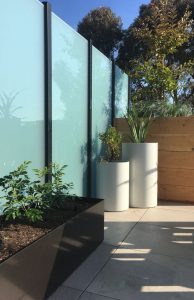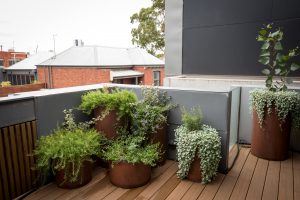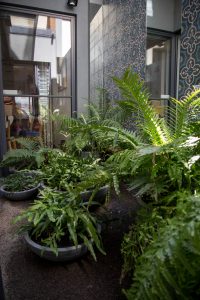Small spaces gardening – The fundamentals
Increasingly, our gardens are becoming smaller spaces, whether that means a compact back garden, a courtyard or a balcony. But this doesn’t mean you can’t have abundant greenery. A small garden can be a little oasis in the midst of our urban sprawl. You can create your own microclimate and cool your space, even grow some trees. You just need to think on a smaller scale – you might not be able to have a 20-metre lemon scented gum in your courtyard garden, but maybe you can plant a grafted variety. Look for grafted corymbia or eucalyptus, or other small tree cultivars, like crepe myrtle ‘zuni’.
The principles of garden design are essentially the same for small and large gardens. However, in a small space there is nowhere to hide, so all components need to work well. Part of having a sustainable garden is getting it right the first time: you don’t want to have to reinvent the whole thing in 12 months because what you put in the first time didn’t work.
START WITH THE FUNDAMENTALS
SOIL:
A vital ingredient of any garden is the soil. For courtyards and small backyards, My driving principle is to work with the soil that is there already. Clients often ask me to remove the existing soil and replace it with new. I usually resist this and prefer to build on what’s there; unless it’s clearly in really bad shape – full of builders rubble or contaminated from paint or concrete runoff.
If you have really sandy soil, add compost and other organic matter and over time this will build up the soil. At the opposite end of the scale, if its a heavy clay, then add gypsum.
You should also use plants that ‘like’ your soil type. For a sandy soil, choose plants that suit a coastal environment; options include westringia, leucaphyta, melaleuca, anigozanthos (kangaroo paw). Look to Western Australian natives for some inspiration. With clay soils, select plants that like poor drainage such as callistemons and bottle brushes. lomandra grasses will also cope well – they’re tough and will cope with almost anything!
One of the most important things for any soil is to add compost. This will increase the organic matter in the soil – its food for your soil. You can buy compost by the bag or make your own. Even a small courtyard or balcony can host a worm farm or Bokashi bucket on the kitchen bench which will reduce your landfill load and feed the soil at the same time.
A big part of nay small garden is likely to be pots.Use potting mix rather than soil in posts. Pots need good drainage and posting mix is designed to deliver air and water to the roots. Remember you get what you pay for. You’ve already invested in pots, planters and plants, so don’t cut short on the potting mix. Use the one that is right for your plants and check if it has fertiliser added to the mix; this can sometimes explain a difference in cost. If it doesn’t include fertiliser , then add a pelletised slow release fertiliser to your posts at the time of planting. Don’t add organic matter to potting mix as this will actual disrupt drainage and air flow; so the usual rules don’t necessarily apply.
Specialised potting mixes are particularly beneficial when planting specific groups of plants. If you are growing succulents then use a succulent mix as it has a more open structure than regular potting mix and is good for both succulents and orchids. The same goes for specialised veggie or native potting mixes; they’ve been design to cater to the specific requirements of those plants. A good all round, all purpose potting mix is ideal for small potted trees, citrus or other fruit trees.

LIGHT:
As with any garden, the amount of sun your space receives will dictate what is possible to grow. Is it shady for most of the day, does it get morning or afternoon sun, or is it a full sun position? This will be dictated by aspect – which way the garden faces- and any surrounding shade.
if your garden races south or is shaded by buildings or large trees, then it may be difficult to grow veggies or fruit trees; instead, you can grow parsley, mint and basil. Citrus trees will be fine but won’t necessarily produce fruit.The sun can also heat up your walls and create a microclimate. This can work in with some plants, but it will also add to pots drying out.
WATER:
All plants need water, even succulents. Of course the amount will vary on the choice of plants but water is still essential.
It is surprising how many balconies have no access to a tap, so you may find yourself carrying a bucket or watering can to do the watering. If that’s your situation, you’ll need to think carefully about the plants you choose and how often you’ll need to water them.
Wether your garden is on a balcony or your backyard, be realistic about how often you will hand-water your pots or garden beds. If you can set up a drip irrigation system and connect it to a battery-operated timer; that way you can be assured your plants are getting watered regularly. Its not hard and there are lots of resources on-line to help you.
Alternatively consult your local specialist irrigation supplier to help you design a system that suits your needs. Take a plan of your garden to the supplier. It doesn’t need to be complex, just a rough layout with with an overall measurement of the area. They’ll also want to know your water flow – check this by timing how long it takes to fill a nine-litre bucket with the tap full on.
One of the potential pitfalls with pots is that the soil dries out and becomes hydrophobic. When this happens the water runs straight through the pot and nothing reaches the plant roots. You will see it on the ground instead. If this happens you will need to rewet the pot. In technical terms you do this via what’s called mechanical agitation or more simply, by making mud pies! Use a hose or watering can to slowly add water to the pot, and stir it in as you pour to mix the water and potting mix together. Eventually the potting mix will hold the water. As an alternative to standard pots and planters, consider using self-wicking pots, which have a reservoir of water under them which ‘wicks’ up to water the plants. Theses are ideal for balconies as they require less frequent watering and delivers water directly to the roots!
As an alternative to standard pots and planters, consider using self-wicking pots, which have a reservoir of water under them which ‘wicks’ up to water the plants. Theses are ideal for balconies as they require less frequent watering and delivers water directly to the roots!
Extract of article that first appeared in Sanctuary Magazine issue 36 words by Kate Smalley – Small Spaces garden design, head designer and managing director.
